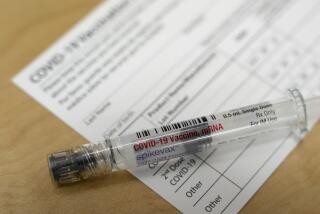Easy Target: an Unvaccinated Population
- Share via
President Bush wants a new Cabinet-level Department of Homeland Security. He has also signed legislation devoting $4.6 billion to battle bioterrorism. But the one simple and most important thing that the federal government can do in the name of homeland security and preventing bioterrorism remains undone: make the smallpox vaccine stockpile available to the American public.
Centers for Disease Control and Prevention officials are meeting behind closed doors this week to determine policy about the smallpox vaccine. Most expect the CDC to stick with some form of the current “ring containment” strategy, whereby government provides smallpox vaccinations after a known outbreak in the hope of containing the spread of the virus. That may make sense for a natural outbreak in a rural area, but such a policy could be disastrous against smallpox bioterrorism. As a course of action, it is unacceptable in a society that values individual life and liberty.
An unvaccinated population is not only vulnerable but an attractive target. A smallpox attack could occur at multiple locations and may not be immediately known--initial symptoms are flu-like, and diagnosis can take 12 or more days. The vaccine must be given within four days of exposure to be effective. As a result, the virus could spread widely and kill thousands before the first vaccinations were given.
Moreover, given a dense and highly mobile population, the virus would probably spread much faster and wider, including to other countries, than a ring containment strategy could keep up with. And in the inevitable post-attack panic and confusion, the medical infrastructure could buckle under the weight of millions of people demanding immediate vaccination.
A better approach would be to take preventive measures now. The U.S. government has 15 million doses of smallpox vaccine that, according to a study published by the New England Journal of Medicine, can be effectively diluted at least fivefold and perhaps more. Combined with about 85 million additional doses of newly discovered smallpox vaccine, plus approximately 200 million doses already ordered by the government, there is more than enough to allow for voluntary vaccination.
Naysayers often claim that the threat of a smallpox bioterrorist attack is remote and that there aren’t significant indicators that such a threat is imminent. Not to put too fine a point on it, but before Sept. 11, the same could have been said of jetliners being hijacked and used as missiles to destroy buildings.
The naysayers also cite the risks associated with smallpox vaccine, claiming that hundreds of people would die and thousands more would suffer side effects if the entire population was vaccinated. This would certainly be the case if there was forced mass vaccination. Because there are known risks, in particular for those with weakened immune systems, individuals should be allowed to make voluntary, informed decisions--in consultation with their doctors--to manage and mitigate those risks. Various polls show that half or more of the public would like to be vaccinated.
The bottom line is that Americans are smart enough to decide for themselves about the smallpox vaccine. The government’s withholding of the vaccine until after an attack assumes otherwise.
Even if only a fraction of the population was vaccinated beforehand, there would be a “community immunity” effect that would lower the rate of transmission of the disease, so the chances of a successful attack would be reduced.
This could also have a deterrent effect and thus might prevent such an attack.
That is common-sense homeland security. The federal government is shirking its primary responsibility to protect the citizenry by withholding the vaccine.
*
Charles V. Pena is the senior defense policy analyst at the Cato Institute. Web site: www.cato.org.
More to Read
Sign up for Essential California
The most important California stories and recommendations in your inbox every morning.
You may occasionally receive promotional content from the Los Angeles Times.













